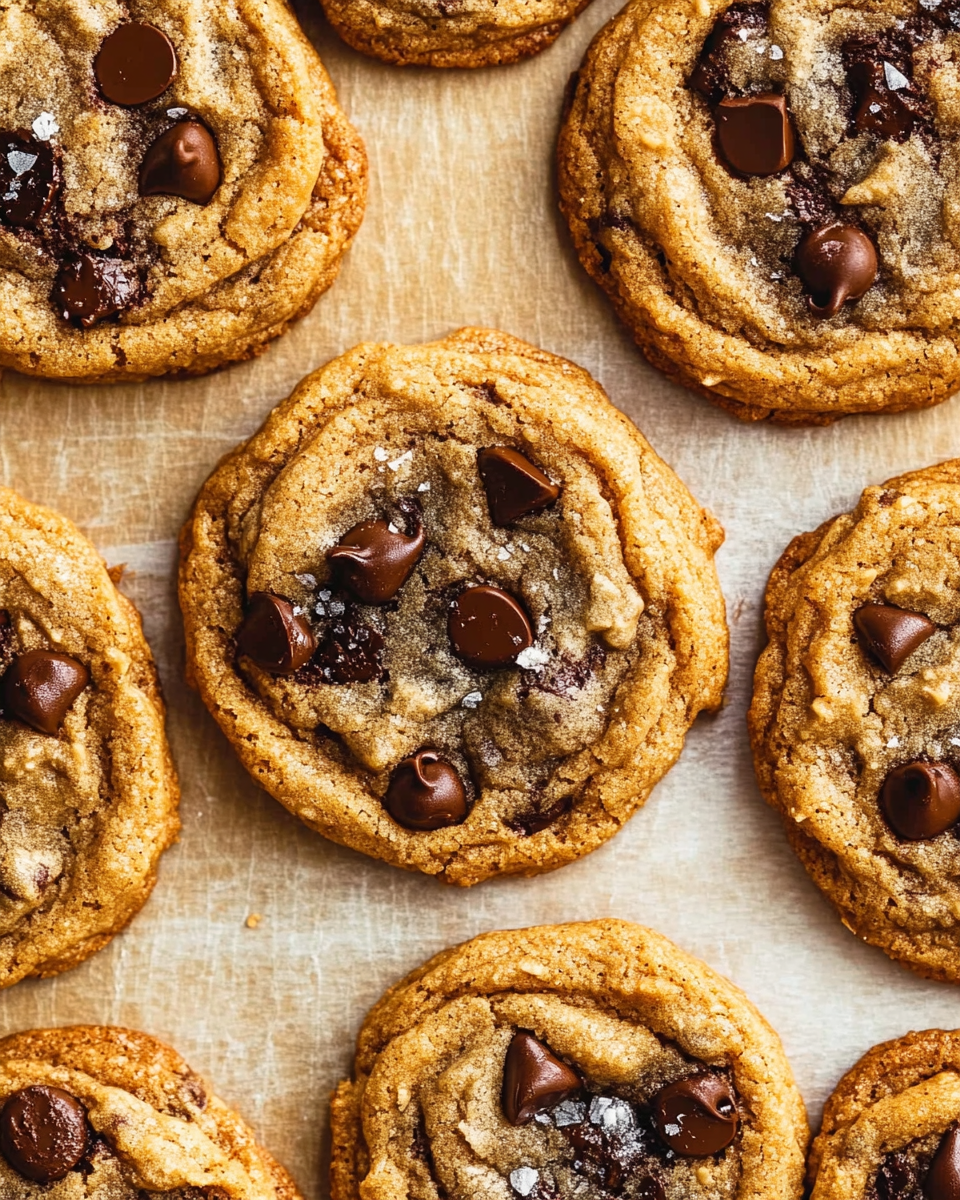These Gluten-Free Chocolate Chip Cookies are chewy, golden, and bursting with melty chocolate chips. Perfect for anyone avoiding gluten without sacrificing flavor, they’re easy to make and loved by all gluten-free or not
FULL RECIPE
Ingredients
- 1 1/4 cups gluten-free all-purpose flour (with xanthan gum)
- 1/2 tsp baking soda
- 1/4 tsp salt
- 1/2 cup unsalted butter, softened
- 1/2 cup packed brown sugar
- 1/4 cup granulated sugar
- 1 large egg
- 1 tsp vanilla extract
- 1 cup semi-sweet chocolate chips
Directions
- Preheat the oven to 350°F (175°C). Line a baking sheet with parchment paper.
- In a medium bowl, whisk together gluten-free flour, baking soda, and salt.
- In a large bowl, cream the softened butter with brown sugar and granulated sugar until fluffy.
- Beat in the egg and vanilla extract until combined.
- Gradually mix in the dry ingredients until a dough forms.
- Fold in the chocolate chips.
- Scoop tablespoon-sized portions onto the prepared baking sheet, spacing them about 2 inches apart.
- Bake for 10–12 minutes, or until the edges are golden and the centers are set.
- Let cool on the baking sheet for 5 minutes before transferring to a wire rack to cool completely.
Nutritional Information
- Calories: 130
- Total Fat: 7g
- Saturated Fat: 4g
- Trans Fat: 0g
- Cholesterol: 20mg
- Sodium: 60mg
- Total Carbohydrates: 17g
- Dietary Fiber: 1g
- Sugars: 10g
- Protein: 1g
What Makes These Cookies Gluten-Free?
Gluten-free chocolate chip cookies replace traditional wheat flour with gluten-free alternatives such as rice flour, almond flour, or a gluten-free all-purpose blend. These blends often include a combination of starches and flours like tapioca, potato starch, and xanthan gum to mimic the texture and elasticity that gluten provides. The xanthan gum acts as a binder, helping the dough hold together and providing structure. This substitution is essential for those with celiac disease or gluten sensitivity to enjoy classic treats without discomfort or health risks.
The Importance of Texture in Gluten-Free Cookies
One challenge with gluten-free baking is achieving the right texture. Traditional cookies owe their chewiness and structure to gluten, so without it, the cookies can easily become crumbly or dry. This recipe balances fats and binding agents to create a chewy and moist cookie that doesn’t fall apart. The softened butter and brown sugar contribute moisture and tenderness, while the proper mix of gluten-free flour and xanthan gum helps maintain shape and chewiness, making these cookies satisfyingly close to their gluten-containing counterparts.
Choosing the Right Gluten-Free Flour Blend
Not all gluten-free flours are created equal. Some are better suited for baking than others. A quality gluten-free all-purpose flour blend usually contains a mix of rice flour, potato starch, tapioca starch, and sometimes sorghum or millet flour. These blends are designed to replicate the properties of wheat flour. Using a premade blend simplifies the baking process and improves consistency. If baking from scratch, it’s important to include xanthan gum or guar gum as a binder, or else the cookies may turn out crumbly or flat.
The Role of Sugar in These Cookies
This recipe uses a combination of brown sugar and granulated sugar, which serves multiple purposes. Brown sugar adds moisture and a slight caramel flavor due to its molasses content, contributing to the cookie’s chewiness. Granulated sugar helps with spreading and crisping the edges. Balancing these sugars ensures the cookies have a perfect texture—crispy on the edges and soft in the center—while delivering that classic sweet flavor everyone loves.
Why Butter is the Best Fat for Flavor and Texture
Butter isn’t just a fat source; it’s also a flavor powerhouse. It lends a rich, creamy taste that vegetable oils or margarine can’t replicate. In gluten-free baking, butter also helps with the texture, giving the cookie a tender crumb and slight crispness. The softened butter used here ensures even creaming with sugar, creating air pockets in the dough that help the cookie rise and achieve a light yet chewy consistency.
Eggs as a Binding and Moisture Agent
Eggs play a crucial role in gluten-free cookies by acting as a binder to hold ingredients together and provide moisture. They help create structure and stability in the absence of gluten. Additionally, eggs contribute to the cookie’s richness and aid in leavening, making the cookies puff slightly while baking. Using a fresh egg at room temperature ensures the best incorporation and texture.
The Importance of Proper Mixing Techniques
Mixing techniques can significantly impact the final cookie quality. Overmixing the dough can cause tough cookies, while undermixing can lead to uneven distribution of ingredients. Creaming the butter and sugars first traps air that helps the cookies rise. Adding eggs and vanilla next ensures smooth incorporation before folding in dry ingredients gently. This approach helps maintain the right balance of tenderness and structure.
How Chocolate Chips Enhance Flavor and Texture
Chocolate chips are the star of chocolate chip cookies, providing pockets of melted sweetness and a satisfying contrast to the dough’s texture. Using semi-sweet chocolate chips adds a nice balance of sweetness and slight bitterness, which complements the caramel notes from the brown sugar. The size and quality of the chocolate chips can affect the cookie experience; high-quality chips melt better and offer a smoother, richer taste.
Baking Tips for Perfect Gluten-Free Cookies
Baking gluten-free cookies requires some care to avoid common pitfalls. Preheating the oven ensures even cooking, while lining the baking sheet with parchment paper prevents sticking and promotes even browning. It’s important to space the dough scoops well to allow spreading. Checking the cookies at the 10-minute mark prevents overbaking, which can dry them out. Letting cookies cool on the sheet for a few minutes allows them to set before transferring, preserving their shape and texture.
Storing and Freezing Gluten-Free Cookies
Proper storage is key to keeping gluten-free cookies fresh and chewy. Store them in an airtight container at room temperature for up to five days. To extend shelf life, freeze the cookies by placing them in a single layer on a baking sheet until firm, then transferring them to a freezer-safe container or bag. When ready to eat, thaw at room temperature or warm briefly in the oven to restore softness and flavor.
Who Can Benefit from This Recipe?
This recipe is perfect for anyone avoiding gluten, including those with celiac disease, gluten intolerance, or wheat allergies. It’s also ideal for people looking to reduce gluten consumption for personal or dietary reasons without sacrificing delicious homemade treats. Additionally, it’s a great option for serving guests with dietary restrictions, ensuring everyone can enjoy a classic dessert together.
Variations and Customizations
These cookies can easily be customized to suit your preferences. For a nuttier flavor, try adding chopped nuts like walnuts or pecans. To switch up the chocolate, use white chocolate chips, dark chocolate, or even peanut butter chips. For extra chewiness, adding a tablespoon of molasses or substituting some butter with coconut oil can provide a subtle twist. You can also experiment with gluten-free oats for texture or add spices like cinnamon for warmth.
Conclusion
Gluten-Free Chocolate Chip Cookies prove that eliminating gluten doesn’t mean sacrificing flavor, texture, or satisfaction. With the right blend of gluten-free flours, proper mixing, and key ingredients like butter and eggs, these cookies deliver a deliciously chewy, rich experience that rivals traditional cookies. Whether for dietary needs or simply a new twist on a classic favorite, this recipe offers a reliable, crowd-pleasing treat. Perfect for any occasion, these cookies make gluten-free baking accessible, tasty, and fun.






